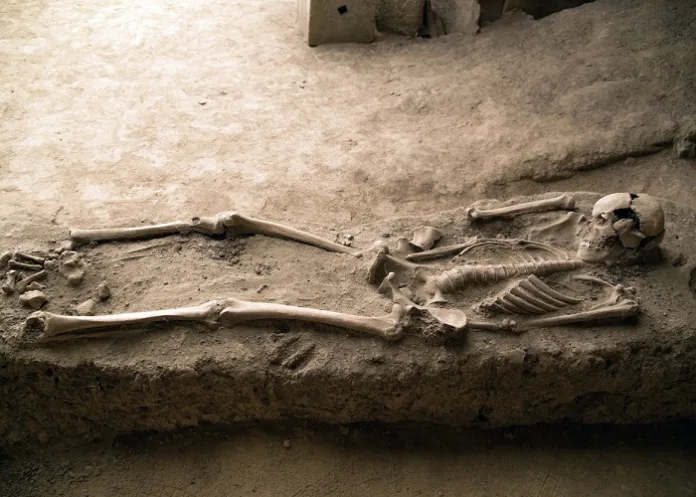A team of scientists has revealed that DNA from the bones and teeth of ancient Europeans – who lived up to 34 000 years ago – is providing insight into the origin of multiple sclerosis, finding that genetic variants that now increase its risk once served to protect people from animal-borne diseases.
For their study, the researchers used ancient DNA sequenced from 1 664 people from various sites across Western Europe and Asia, which was then compared with modern DNA from the UK Biobank, comprising about 410 000 self-identified “white-British” people, and more than 24 000 others born outside the UK, to discern changes over time.
Reuters reports that the researchers identified a pivotal migration event about 5 000 years ago at the start of the Bronze Age when livestock herders, called the Yamnaya people, moved into Western Europe from an area that includes modern Ukraine and southern Russia.
They carried genetic traits that back then, were beneficial, protective against possible infections from their sheep and cattle. As sanitary conditions improved over the millennia, these same variants increased MS risk.
The scientists said this helps explain why Northern Europeans have the world’s highest MS prevalence, double that of Southern Europeans.
“We are a product of the evolution that happened in past environments, and in many ways we are not optimally adapted to the environment we have created for ourselves today,” said University of California-Berkeley population geneticist Rasmus Nielsen, one of the leaders of the research published in the journal Nature.
Around 11 000 years ago, farmers from the area of modern Turkey expanded into Western Europe, replacing hunter-gatherers. It was these agriculturalists whom the Yamnaya later replaced.
“The Yamnaya were Europe’s first true nomads. They used domesticated cattle and horses to access the interiors of the Asian Steppe, where there is little to eat or drink, so carried everything with them on wagons. Physically they were unusually large, which we can see by measuring the skeletons and also genetically, and apparently, were also fairly violent,” University of Cambridge geneticist and study co-author William Barrie said.
“We think that much of the replacement that happened involved warfare,” Nielsen added.
High Yamnaya-related ancestry exists in Northern Europeans, peaking in Ireland, Iceland, Norway and Sweden, and decreasing further south.
The findings underscore how genetic traits can change from beneficial to deleterious as conditions evolve.
“Pathogenic infections increased in frequency during the Bronze Age, due to close proximity between people and their domestic animals, as well as rising population density,” University of Copenhagen computational evolutionary biology specialist and research co-author Evan Irving-Pease said.
“It was not until the modern era, with widespread sanitation and medical care, that these genetic variants became surplus to our immunological requirements, resulting in an increase in the risk of developing MS and other autoimmune diseases.”
The findings may carry implications for MS research and treatment.
“This changes our view of MS, helping us understand its origins. We can see MS as the result of an immune system that has efficiently evolved to cope with a range of infections in the human past but which now exists in a very different environment,” said Barrie. “This difference between the past and modern sanitary environments possibly causes the overactive immune system, and implies we should be aiming to recalibrate the immune system rather than suppress it.”
The research has shed light on other characteristics of Europeans.
Because the Yamnaya were genetically predisposed to being tall, present-day Northern Europeans tend to be taller than Southern Europeans, who have greater ancestry from Neolithic farmers who were genetically predisposed to being short.
Eastern Europeans have a heightened genetic risk for Alzheimer’s and type 2 diabetes, the researchers found. They also discovered that lactose tolerance, the ability to digest the sugar in milk and other dairy products, emerged in Europe approximately 6 000 years ago.
Study details
Population genomics of post-glacial western Eurasia
Morten Allentoft, Martin Sikora, Eske Willerslev, et al.
Published in Nature on 10 January 2024
Abstract
Western Eurasia witnessed several large-scale human migrations during the Holocene. Here, to investigate the cross-continental effects of these migrations, we shotgun-sequenced 317 genomes – mainly from the Mesolithic and Neolithic periods – from across northern and western Eurasia. These were imputed alongside published data to obtain diploid genotypes from more than 1 600 ancient humans. Our analyses revealed a ‘great divide’ genomic boundary extending from the Black Sea to the Baltic. Mesolithic hunter-gatherers were highly genetically differentiated east and west of this zone, and the effect of the neolithsation was equally disparate. Large-scale ancestry shifts occurred in the west as farming was introduced, including near-total replacement of hunter-gatherers in many areas, whereas no substantial ancestry shifts happened east of the zone during the same period. Similarly, relatedness decreased in the west from the Neolithic transition onwards, whereas, east of the Urals, relatedness remained high until around 4 000 BP, consistent with the persistence of localised groups of hunter-gatherers. The boundary dissolved when Yamnaya-related ancestry spread across western Eurasia around 5 000 BP, resulting in a second major turnover that reached most parts of Europe within a 1 000-year span. The genetic origin and fate of the Yamnaya have remained elusive, but we show that hunter-gatherers from the Middle Don region contributed ancestry to them. Yamnaya groups later admixed with individuals associated with the Globular Amphora culture before expanding into Europe. Similar turnovers occurred in western Siberia, where we report new genomic data from a ‘Neolithic steppe’ cline spanning the Siberian forest steppe to Lake Baikal. These prehistoric migrations had profound and lasting effects on the genetic diversity of Eurasian populations.
Nature article – Population genomics of post-glacial western Eurasia (Open access)
See more from MedicalBrief archives:
How Epstein-Barr virus is linked to MS – Swedish study
FDA approves first natalizumab biosimilar for MS
Misdiagnosis of multiple sclerosis found to be common

